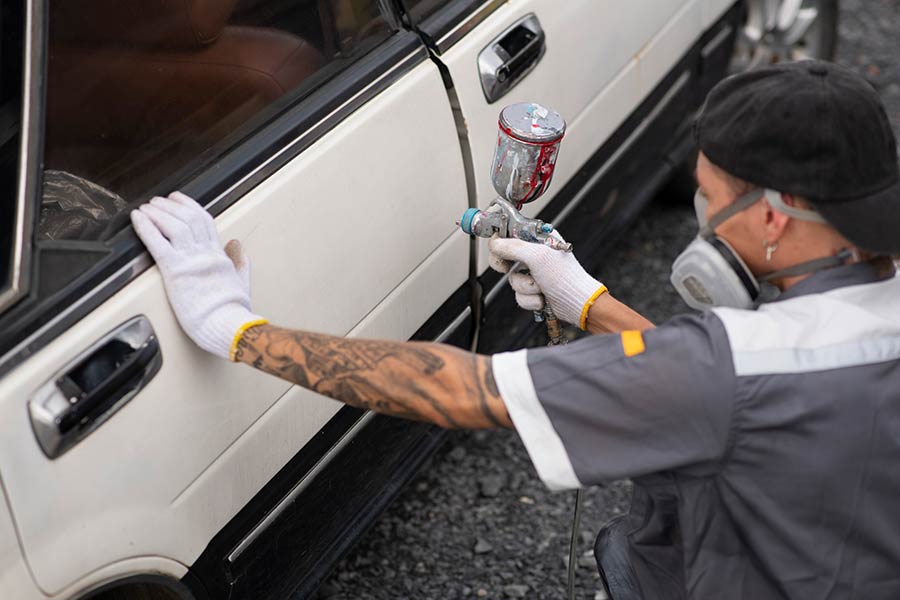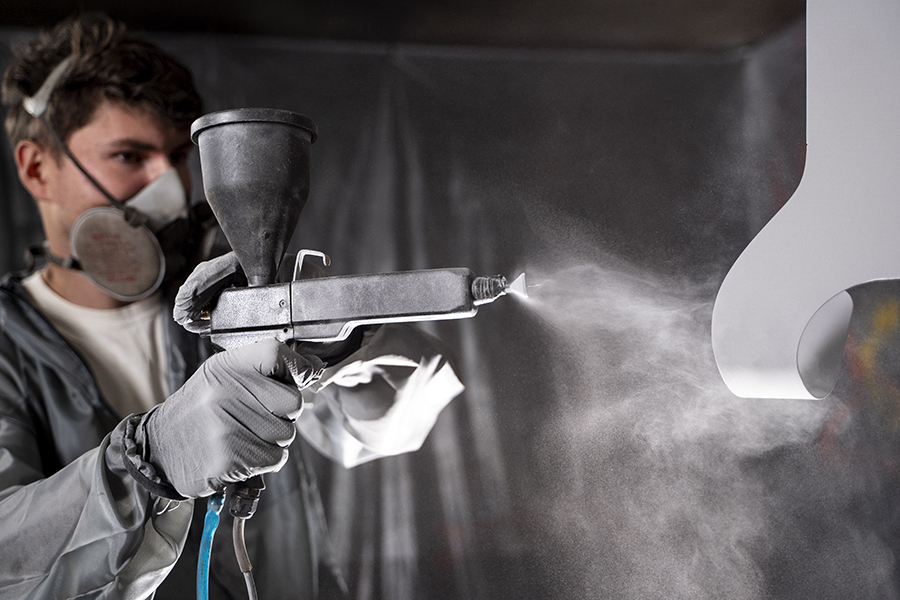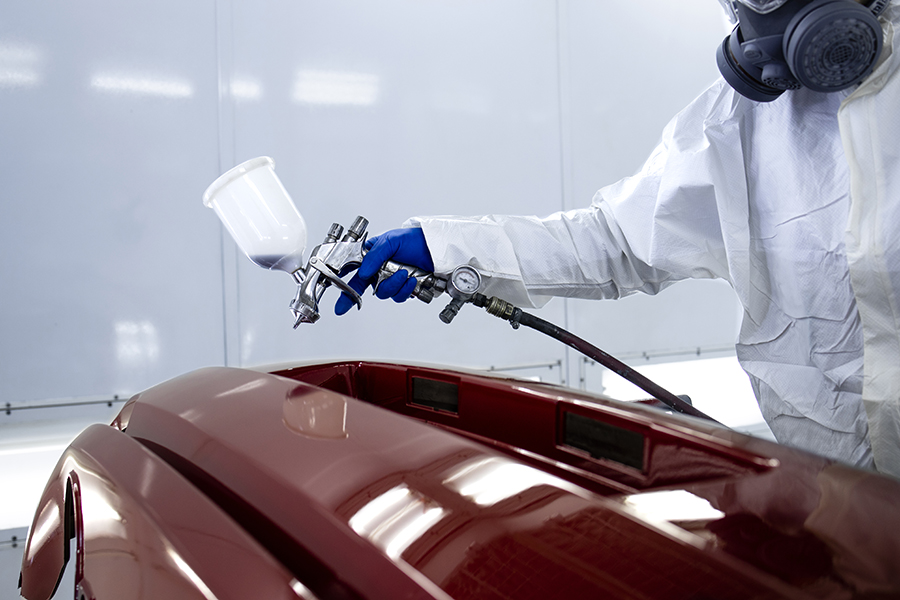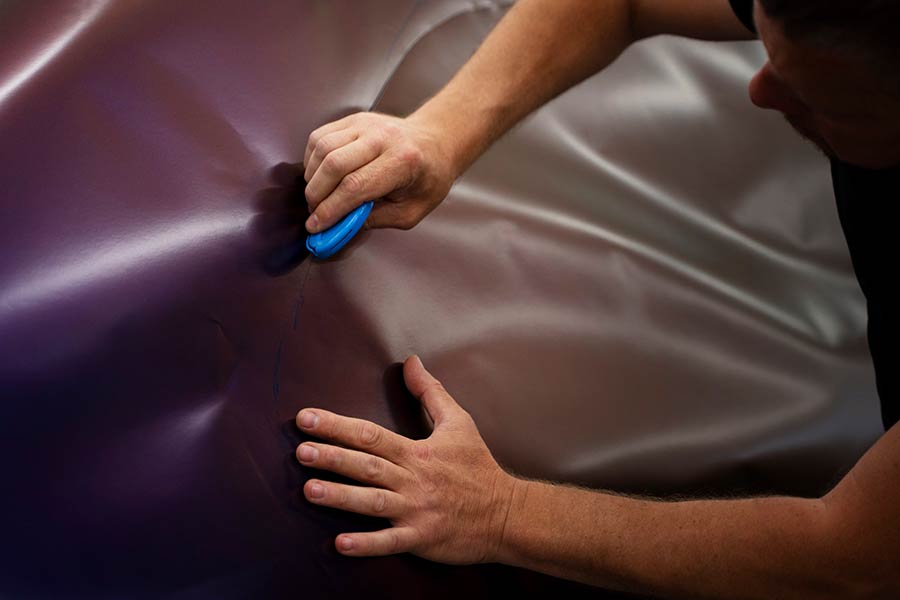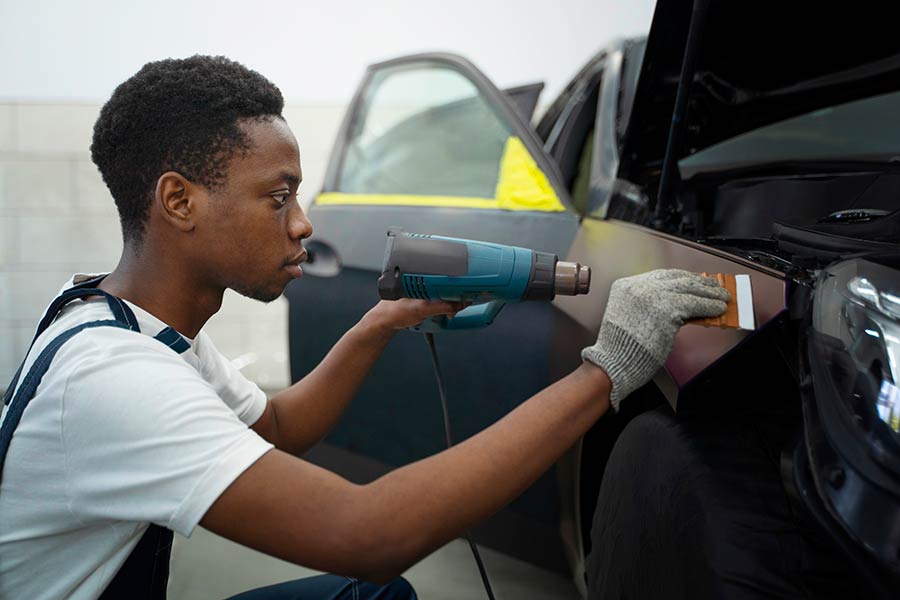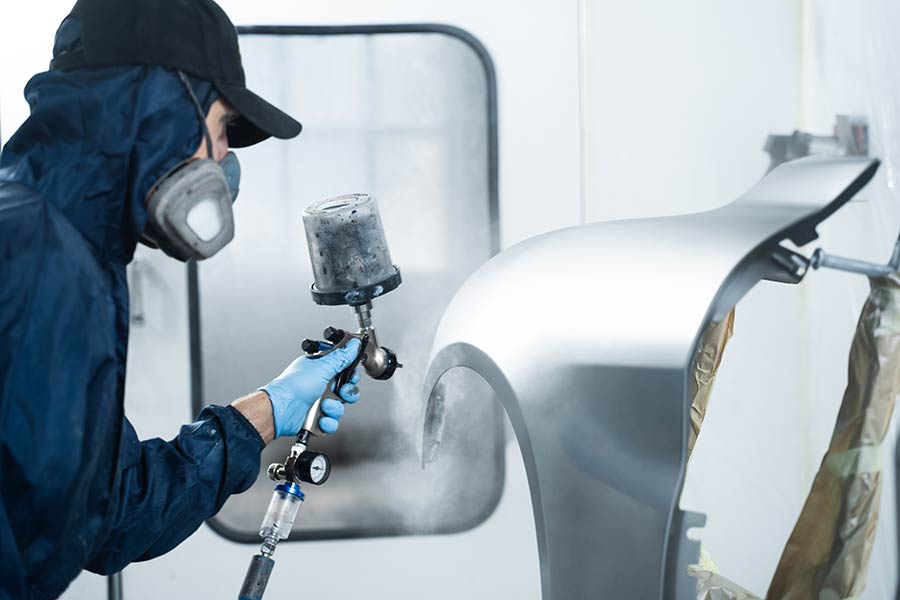Did you know that the average car loses up to 33% of its resale value due to visible paint damage?
That small scratch or sun-faded spot isn’t just a cosmetic issue - it’s literally taking money out of your pocket. As a car owner, I’ve seen how quickly minor paint problems can turn into major headaches, affecting both the look and worth of your vehicle.
The good news? Most paint damage is fixable, whether it’s a tiny chip from road debris or widespread oxidation from sun exposure. Modern vehicle paint repair combines advanced technology with time-tested techniques to bring back your car’s showroom shine.
In this guide, we’ll walk through everything you need to know about fixing your car’s paint - from spotting different types of damage to choosing between DIY fixes and professional repairs. Let’s help you bring your car’s finish back to life!
Paint Damage Assessment
When I assess paint damage on vehicles, I look at three critical aspects that determine the best repair approach. Let’s break these down to help you make informed decisions about your vehicle paint repair.
Types of Paint Damage
Paint damage comes in various forms, each requiring different repair methods. Here’s what I typically see:
| Damage Type | Characteristics | Common Causes |
|---|---|---|
| UV Damage | Fading, dull finish | Sun exposure |
| Clear Coat Failure | Peeling, cloudy areas | Age, weather exposure |
| Chemical Damage | Etching, discoloration | Bird droppings, tree sap |
| Physical Damage | Scratches, chips | Road debris, accidents |
Evaluating Repair Costs
The price of paint repairs varies based on several key factors:
- Paint quality and type needed
- Size of the damaged area
- Vehicle location and local labor rates
- Required surface preparation
- Paint matching complexity
DIY vs Professional Repair
I’ve seen both successes and failures in DIY paint repairs. Here’s what you should think about:
Professional repairs offer access to high-grade equipment and materials. They use premium paints and clear coats that last longer and look better. The work typically comes with warranties, adding value and peace of mind.
DIY approaches can save money but require significant time investment. For small jobs, materials might cost $200-$600. However, achieving professional-quality results needs proper ventilation, safety gear, and considerable skill. Weather conditions also affect the final look.
The choice between DIY and professional work depends on your goals. Small touch-ups might work well as DIY projects, but larger jobs often need professional expertise for the best results. Remember that improper DIY techniques can lead to uneven coating and dust particles in the paint, potentially requiring costly professional fixes later.
Professional Paint Repair Methods
I’ve worked with numerous professional paint repair facilities, and I’m amazed at how far the technology has advanced. Let me show you the most effective professional methods that will bring your car’s finish back to life.
Body Shop Techniques
Professional body shops now work with advanced spot repair techniques that fix damage while keeping costs down. I’ve seen remarkable results using these methods:
| Repair Method | Best For | Time Required |
|---|---|---|
| Spot Repair | Small areas, scratches | 2-4 hours |
| Partial Paint | Panel damage | 1-2 days |
| Full Repaint | Major damage | 3-5 days |
Mobile Repair Services
Mobile repair teams bring the shop to you. Through my experience with these services, I can tell you they’re perfect for busy car owners. They use Small to Medium Area Repair Techniques (SMART) that fix minor damage right in your driveway. These teams carry specialized tools and high-quality materials that match factory finishes.
Paint Matching Technology
The most impressive advancement I’ve seen is in paint matching systems. Modern shops use spectrophotometers that read your car’s exact color. Here’s what makes this technology amazing:
- Creates precise color formulas by analyzing light reflection
- Matches even complex metallic and pearl finishes
- Works with water-based and solvent-based paints
- Accounts for paint aging and weathering
Through my years in the industry, I’ve watched digital paint matching transform from a luxury to a must-have. The system analyzes thousands of color variations to find the perfect match. When combined with skilled technicians, these tools create repairs that blend perfectly with your car’s original finish.
I always tell my clients that professional paint repair isn’t just about fixing damage - it’s about maintaining their car’s value. The right repair method, paired with advanced color matching, makes damage disappear like it never happened.
DIY Paint Repair Steps
After years of doing my own vehicle paint repair, I can tell you that success comes down to having the right tools and following proper techniques. Let me share my proven approach that will help you achieve professional-looking results.
Required Tools and Materials
I always make sure to have these essential items ready before starting:
| Basic Tools | Safety Equipment | Paint Materials |
|---|---|---|
| Sandpaper (220-3000 grit) | Safety glasses | Color-matched paint |
| Masking tape | Face mask | Primer |
| Microfiber cloths | Work gloves | Clear coat |
| Cleaning supplies | Protective clothing | Cutting compound |
Surface Preparation Methods
I’ve learned that proper preparation makes the difference between an amateur and professional-looking job. Here’s my tested process:
- Clean the damaged area with soap and water
- Remove all traces of wax using rubbing alcohol
- Sand the area with 220-grit paper for bare metal spots
- Clean again and apply primer if metal is exposed
- Let primer dry completely (usually 20-30 minutes)
Application Techniques
The key to getting great results lies in the application method. I start by testing the paint on a small, hidden area to check the color match. For the actual repair:
Base Coat Application: * Apply thin, even layers of paint * Wait 15-20 minutes between coats * Build up color gradually * Keep the spray can 6-8 inches away
Clear Coat Process: * Apply 2-3 light layers of clear coat * Allow proper drying time between coats * Wait 48 hours before buffing * Use cutting compound to blend edges
I make sure to work in a clean, well-ventilated area with temperatures between 65-75°F for the best results. Remember, rushing the process will only lead to disappointing results - take your time with each step.
Paint Protection Strategies
I’ve spent years protecting vehicles from paint damage, and I’m going to share my most effective strategies. The right protection can save you thousands in future repairs.
Ceramic Coating Benefits
My experience with ceramic coatings has shown remarkable results. These coatings create a chemical bond with your car’s paint that lasts for years. Here’s what makes them special:
| Protection Feature | Duration | Benefits |
|---|---|---|
| UV Resistance | 5-10 years | Prevents fading |
| Chemical Protection | 5+ years | Stops etching |
| Hydrophobic Surface | 2-5 years | Makes cleaning easier |
Paint Protection Films
I’ve seen paint protection films (PPF) stop rock chips that would have needed costly repairs. Modern PPF technology includes:
- Self-healing properties that remove minor scratches
- Strong impact resistance for high-traffic areas
- Clear, nearly invisible appearance
- Protection against road debris and chemicals
The best part? These films last 5-10 years when properly maintained. I recommend applying them to high-impact areas like the hood, bumpers, and side mirrors.
Maintenance Schedule
My tested maintenance routine keeps protection systems working at their best:
Weekly Tasks: * Gentle wash with pH-neutral soap * Quick inspection for new damage * Spot cleaning of bird droppings
Monthly Tasks: * Deep cleaning of protected surfaces * Check for edge lifting on films * Apply ceramic coating boosters
Yearly Tasks: * Professional inspection of protection * Paint correction if needed * Reapplication of ceramic spray coatings
I’ve found that following this schedule extends protection life by 30-40%. For ceramic coatings, I use specific pH-neutral cleaners that won’t break down the protective layer. With PPF, I avoid high-pressure washing near the edges.
Both ceramic coatings and PPF work together beautifully. I often recommend ceramic coating over PPF for maximum protection. This combination has kept my clients’ vehicles looking new for years, saving them money on paint repairs and maintaining higher resale values.
Value Restoration Tips
Looking at my years of experience in paint restoration, I can tell you that bringing back your car’s value starts with understanding the right techniques. Let me show you how proper paint correction can transform your vehicle’s worth.
Paint Correction Process
The path to perfect paint isn’t quick, but it’s worth every minute. I start with:
| Correction Level | Results | Time Investment |
|---|---|---|
| Light Polish | Removes 30-50?fects | 4-6 hours |
| Two-Stage | Removes 50-85?fects | 1-2 days |
| Multi-Stage | Removes 85%+ defects | 2-3 days |
My approach focuses on removing the minimum amount of clear coat needed while getting maximum results. This keeps your paint system strong for years to come.
Clear Coat Restoration
I’ve seen too many cars with failing clear coats, and it’s always cheaper to fix early. The clear coat isn’t just shine - it’s your paint’s armor. When I work on clear coat restoration, I look at:
- Paint thickness measurements
- UV damage assessment
- Surface contamination levels
- Previous repair history
The goal? Bringing back that protective layer while keeping enough thickness for future corrections. I’ve found that proper clear coat restoration can add hundreds, even thousands, to your car’s value.
Paint Finish Enhancement
The final stage makes all the difference. Through careful machine polishing, I bring out:
- Deep color saturation
- Mirror-like reflections
- Smooth-as-glass feel
- Lasting protection
My clients often tell me their cars look better than when they left the showroom. That’s because modern finishing techniques go beyond just making paint look good - they create a finish that lasts.
I always measure my success by the “walk-away test.” When you park your car and walk away, do you turn around for one more look? If yes, we’ve done it right. This pride in ownership translates directly to higher resale value.
Remember, paint correction isn’t just about looks. It’s an investment that pays off when it’s time to sell or trade in your vehicle. I’ve seen properly corrected paint add significant value to vehicles, sometimes recovering the entire cost of the correction process.
Conclusion
Paint damage affects both your car’s appearance and its market value. Through proper assessment, repair techniques, and protection methods, you can maintain your vehicle’s pristine finish for years. My experience shows that combining professional expertise with regular maintenance creates lasting results.
Right now is the perfect time to take action for your vehicle’s paint care. Whether you need minor touch-ups or complete paint correction, I recommend you Schedule Repair with qualified professionals who understand modern paint technology and protection systems.
Paint care represents more than surface beauty - it’s a smart investment in your vehicle’s future. Regular maintenance, timely repairs, and proper protection will keep your car looking showroom-fresh while preserving its resale value. Remember, small paint issues fixed today prevent bigger problems tomorrow.
## FAQs
-
How much does professional paint repair typically cost? The cost of professional paint repair varies depending on several factors, including the extent of the damage, the quality of paint used, and local labor rates. Small touch-ups can cost a few hundred dollars, while a full repaint may run into thousands. It’s best to get quotes from reputable body shops for an accurate estimate based on your specific situation.
-
Can I repair my car’s paint damage myself? Yes, you can perform DIY paint repairs for minor damages like small scratches or chips. However, it requires proper tools, materials, and techniques to achieve good results. For larger damages or if you’re unsure about your skills, it’s recommended to seek professional help to avoid potentially costly mistakes.
-
What’s the difference between ceramic coating and paint protection film? Ceramic coating is a liquid polymer that chemically bonds with the car’s paint, providing a durable protective layer against UV rays, chemicals, and minor scratches. Paint protection film (PPF) is a clear, self-healing urethane film physically applied to the car’s surface, offering stronger protection against rock chips and road debris. Both can be used together for maximum protection.
-
How long does a professional paint job last? A high-quality professional paint job can last for many years with proper care and maintenance. Factors affecting longevity include the quality of materials used, application techniques, and how well the vehicle is maintained. Regular washing, waxing, and protection from environmental factors can significantly extend the life of your paint job.
-
What’s the best way to protect my car’s paint from damage? The best protection strategy combines several approaches:
- Regular washing and waxing
- Applying a ceramic coating or paint protection film
- Parking in covered areas when possible
- Promptly cleaning off contaminants like bird droppings or tree sap
- Avoiding automatic car washes with abrasive brushes
-
Addressing small damages quickly before they worsen
-
How can I tell if my car needs paint correction? Signs that your car might need paint correction include: - Visible swirl marks or fine scratches - Dull or faded appearance - Rough texture when running your hand over the paint - Lack of deep reflections in the paint If you notice these issues, a professional detailer can assess whether paint correction would benefit your vehicle.
-
What’s the process for matching my car’s paint color? Professional body shops use advanced spectrophotometers to analyze your car’s exact color, accounting for fading and weathering. This technology creates a precise color formula that matches even complex metallic and pearl finishes. For DIY repairs, you can often find touch-up paint matched to your car’s color code, usually located on a sticker in the door jamb or under the hood.
-
How often should I have my car’s paint professionally detailed? For optimal paint maintenance, it’s recommended to have your car professionally detailed once or twice a year. However, this can vary based on factors like your local climate, how often you drive, and where you park your car. Regular at-home maintenance between professional details can help keep your paint in top condition.
